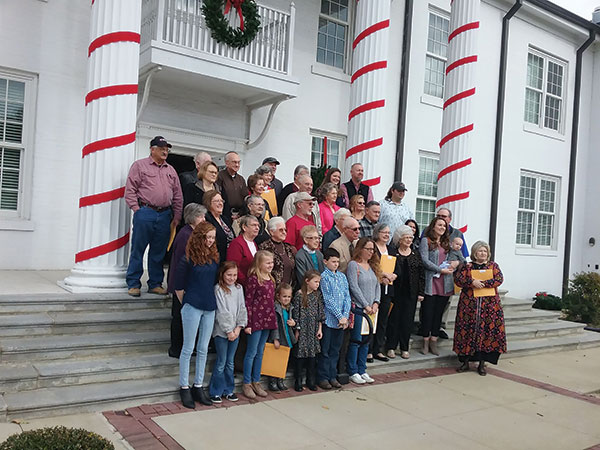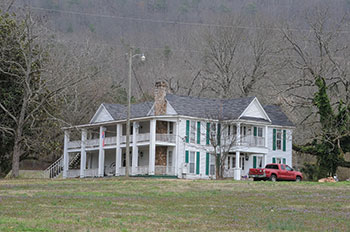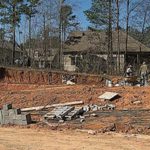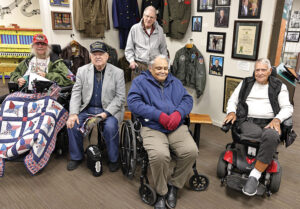

The foundation for generations
Story by Joe Whitten
Photos by Wallace Bromberg Jr.
Submitted photos
In 2017, Kathy Burttram and Rose Mary Hyatt had a bee of an idea buzzing in their proverbial pioneer sunbonnets. Together, they developed the idea into a reality that is as satisfying to a lover of local history as honey on a hot buttered biscuit was to a family at breakfast in a log cabin. They called their project The First Families of St. Clair County, Alabama, and brought it to fruition during the county’s bicentennial year, 2018.
Having loved local history for years, the two women were knowledgeable and capable of accomplishing their goal. The aim of First Families is to collect and preserve the lineages of families who settled in the county by 1818 or earlier. To be accepted as a member of First Families, the applicant had to provide documented proof of descent from the settler-ancestor.
With plans finalized by late 2017, announcements appeared in libraries and newspapers, and soon requests for application guidelines began to arrive. As completed membership forms came in, the project team began vetting documentation, the number of names on the eligible list increased, and on November 20, 2018, First Families presented membership certificates to 51 descendants of early settlers.
Wendy Smith’s documentation as a descendant of James Ash arrived first. Later, four others joined under his name.
From Franklin County, Georgia, James and wife Nancy Martin Ash arrived in this area shortly after his brother John Ash had settled in Beaver Valley in 1817. James Ash prospered as a successful farmer and acquired much land. He died in 1860, leaving a large estate.
James’ son, William, born in Springville in 1819, also farmed and owned 357 acres in Branchville.
When the Civil War began, William and his sons, James Lafayette and William Gilbert, joined the First Tennessee & Alabama Independent Vidette Cavalry at Bridgeport, Alabama. However, William’s brother, Gabriel Simon, fought for the Confederacy.
In August 1864, William and William Gilbert, with a unit that had loaded cotton for Union use onto wagons, had stopped for the night near Woodville, Alabama. That night, Confederate troops ambushed them, killing all but 14. William and son died. The survivors were taken across the Tennessee River, where they were mowed down in a volley of shots. However, John Kenner survived to tell of the experience.
James Lafayette survived the war and returned to St. Clair County.
St. Clair County had a number of Union sympathizers. In her History of Steele, Alabama, Vivian Qualls noted that only 14 percent of St. Clair landowners owned slaves. Most farmers took care of themselves, with family members doing the work. Mrs. Qualls wrote, “…brothers fought against each other, one with the North and one with the South.”

Twenty persons qualified for membership with ancestor Absalom Autrey. (The name came to be spelled “Awtrey.”) Gerald Tucker, first to qualify as a descendant of Absalom, lives today on the farm that belonged to his great grandfather, James Monroe Awtrey, who was the great grandson of Absalom. James Monroe had inherited the farm from his father, James Henry Awtrey. Gerald Tucker records that James Henry wasn’t a wealthy farmer, but that he gave each of his sons $2,000.00 and “…told them to go out and make their own way.” Tucker also stated, “James Monroe Awtrey, having fought for the North in the Civil War, chose to go to Missouri afterward. He and his wife both died of an illness within five months of each other. James Henry Awtrey brought the two children, Phillip and Zula, back to St. Clair County to live with him.” Frances Leona Awtrey, daughter of Phillip, was Gerald Tucker’s mother.
One Autrey/Awtrey family historian states that Absalom came into our area in 1806 or 1807, settling at the foot of Blount Mountain. Later he owned 153 acres at Greensport on the Coosa River.
However, in a November 29, 2018, St. Clair Times article, qualifying descendant James South stated that the Absalom Autrey family came here toward the end of the 18th Century. “There was an Indian massacre that killed his wife and two or three of his children. He moved back to Georgia territory, and in 1800, he moved back into St. Clair County near Greensport.”
According to oral history, Absalom died November 13, 1833 — the night of the spectacular meteor shower which still lives in state history as “the night stars fell on Alabama.” He was buried near Greensport.
Mary Dearman is the only woman through whom a membership in First Families has come. Moving her family here from South Carolina around 1816-17, Mary is known as the founder of Dearman’s Chapel Methodist Church near Steele — a worthy remembrance by any measure.
Four joined First Families through Revolutionary War veterans Noel Battles and Captain Edward Beeson.
Mattie Lou Teague Crow recorded that Noel Battles lived in Albemarle County, Virginia, in 1776 when he enlisted in “Captain Clough Shelton’s Company which saw service under Colonels Edward Stevens, John Green and Samuel Cabell, respectively.”
At the Birmingham Library, Mrs. Crow discovered on microfiche Noel Battles’ account of his three years in the American Revolution. In an article she wrote, “He fought in the Battle of Trenton and stated that the battle was brief and bloody. The enemy was soon overcome as many of them were drunk after the long Christmas celebration. …The Battle at Brandywine Creek was a painful experience as they were badly beaten by General Howe’s men. Seven hundred were killed or taken prisoner and Noel Battles received a flesh wound in his right arm.” Battles was wounded again at the Battle of Monmouth, June 1777.

After the war, Noel and his wife, Rhoda, moved to Georgia, and from Georgia, into what would become St. Clair County Alabama. He and Rhoda are buried in Old Shiloh Church Cemetery on Highway 11 between Steele and Attalla. This church’s location is now in Etowah County, although it was in St. Clair County when the Battles died. On April 19, 1998, the Etowah County Chapter of the Sons of the American Revolution honored the memory of Noel Battles with a grave marker.
According to local records, Edward Beeson / Beason and wife, Ann, settled in today’s St. Clair County around 1814, where they built a log cabin and “…lived among the Indians until they were removed.”
Edward enlisted in the army in the spring of 1778, Guilford County, North Carolina. He was commissioned Captain in April 1779 and served in Captain David Brower’s Company.
Edward and Ann are buried at Union Beason Cemetery. His grave was marked by the Nancy Hart Chapter of the Daughters of the American Revolution.
Edward’s son, Curtis Grubb Beason, participated in county and state government all his life. He served on the Alabama Constitutional Convention in 1865, according to The Heritage of St. Clair County, Alabama. The antebellum home he built (c1840) still stands, well-kept, in Beason’s Cove between Ashville and Oneonta.
Rev. Thomas Newton and wife Ann Martin Newton were the parents of Margaret Newton who married John Ash, of political renown in St. Clair County. In 1817, both families joined a westward bound caravan from South Carolina as it journeyed through Georgia. The caravan had stopped to rest in today’s Beaver Valley a few miles below present-day Ashville. When a tragic accident left Betsy Ann Ash dead, John and Margaret Ash and Thomas and Ann Newton chose to settle in Beaver Valley rather than abandon Betsy Ann’s grave.
The log home that Ash and Newton first constructed in 1817 stands — the oldest surviving structure in St. Clair County. Both families lived there until John Ash built his own dwelling in 1818.
As years progressed, John Ash added to his home, until it stood a welcoming home in the county.
Some of our older readers will remember the white-painted home standing pristine in the sun; however, the home today stands forlorn in Beaver Valley.
John Ash helped organize the government of St. Clair County. Records show that he was the first elected judge in the county and that he served three terms as state senator. The naming of the county seat Ashville honored the legacy of John Ash. One person provided proof of John Ash lineage.
In his book, Branchville, Alabama: The History of a Little Town, 1819-2007, Kenneth Hodges wrote about Rev. Thomas Newton, stating that, as a minister of the Presbyterian church, “Thomas was an excellent, impressive, emotional preacher with the ability to deliver sermons that would often melt both the speaker and the listener to tears.”
In Georgia, Newton had been a circuit-riding pastor, preaching at a different church each Sunday of the month. Hodges records that when the westward migration began, church membership dwindled as the population of communities decreased. Hodges gives this as a reason for the Newtons joining the westward caravan.
Both a Newton historian and Mattie Lou Teague Crow mention that the Newtons were instrumental in organizing the Presbyterian Church in Ashville. The denomination first met at Mount Pleasant Meeting House, which was also the place of worship for the Methodist and Baptist. In 1879, the Presbyterians erected their own modern Victorian church, still standing in Ashville today.
Three persons gained membership on Rev. Thomas Newton’s name.
Jeremiah Collins arrived here penniless in 1818—according to some accounts. However, Jeremiah Collins’ great great granddaughter, Barbara Goldstein Bonfield, stated in an email interview that Collins researcher, Kathie Collins Jones, “…found land records from South Carolina with Jeremiah and William Collins listed on them, tons of them.” Great great grandson Jimmy Goldstein believes this indicates that Jeremiah didn’t leave South Carolina so poor he had to bring his possessions to Alabama on a sled instead of a wagon, as some researchers have written.
Writing for The Heritage of St. Clair County, Alabama, Bonfield said that Jeremiah settled along the Coosa River and announced his goal of becoming a landowner. Records show that he owned land in Easonville and Ragland in St. Clair County and substantial acreage in Talladega County. Bonfield tells of a deed, dated June 25, 1842, which transferred to Jeremiah 300 acres of land in the “Coosa Land District acquired by the United States in a treaty with the Creek Indians.” President Tyler signed the deed.
Jeremiah achieved his goal of possessing land, but his son, Jesse Collins had other goals —preaching the gospel of Christ. What a disappointment to Jeremiah, who desired his son to become prominent in Alabama politics. Bonfield writes that Jeremiah told Jesse “…he was not raising a son to be a ‘back-woods Baptist preacher.’”
Jesse returned to South Carolina where he continued to study theology, professed his faith in Christ, and became a minister of the Gospel. Jesse returned to St. Clair County with his bride and began pastoring Baptist churches in the county. During his ministry, he pastored several churches in St. Clair, Shelby and Calhoun counties and helped found a number of Baptist churches.
Jesse had obtained his goal of preaching the Gospel, but his father, Jeremiah, had never embraced Christ nor expressed interest in Christianity. Jesse longed for his father to accept Christ and be baptized. His longing was fulfilled, when at age 91, Jeremiah became a Christian and was baptized.
But who baptized Jeremiah? Mattie Lou Teague Crow wrote that “…frail Jeremiah was strapped into a small chair and the preacher son lowered him into the waters of the Coosa River in baptism.” However, Barbara Bonfield records that in a 1927 written document, Jeremiah’s granddaughter, Magnolia Embry, stated that “…her grandfather was baptized by Reverend Renfro in Chocolocco Creek near Schmit’s Mill in Talladega County. Such are the mysteries of family history.
Jeremiah died in 1873, age 94. Jesse died tragically of a pistol shot. The fact that accounts differ on how the pistol discharged doesn’t diminish the Gospel ministry of Jesse A. Collins and the spiritual legacy he left in St. Clair County. Collins was well-known among Alabama Baptists.
B.F. Riley, in his History of the Baptists of Alabama, recorded that “As financial secretary of Howard College, corresponding secretary of the East Alabama Baptist Convention, and pastor in St. Clair County, Mr. Collins rendered valuable service.”
One other minister must be noted. Hezekiah Moor settled in today’s Moody/Leeds area. Moor history is recorded at length in Leeds…Her Story. Hezekiah’s son, also named Hezekiah, was a Baptist minister who helped organize churches in St. Clair County. The record of his death and the vengeance of his son are matters of record.
Rev. P.S. Montgomery wrote in the Southwestern Baptist, February 4, 1864, that Hezekiah was murdered by a bushwhacker on Kelley’s Creek Road during the Civil War. “Having returned home on furlough, he found much mischief was being done by robbers in this county. …Bro. M. gathered a company of men and was indeed successful in catching them. But alas! About the middle of May 1863, as he was returning home alone, a wretch secreted himself by the way, and committed the awful deed and fled.”
The Leeds history states that the man who killed Rev. Moor was Jeff Darty, a soldier who had deserted the company commanded by Hezekiah’s brother.
Hezekiah’s son, Joseph, was eight when his father was killed. When he turned 14, he set out to find Darty in Texas where he had fled. Joseph joined up with a cattle drive, and within three years ended up in the same cattle drive as Jeff Darty.
The cowboys ended a long-day’s drive, and “…after all the cowboys had rolled up in their blankets for a night of well-earned rest, Joe slipped to Darty’s bedroll, took out his knife and slashed Darty’s throat, killing him instantly. Vengeance was his at last. Joe saddled his horse that very night and came back home to Alabama.”
The enchantment of St. Clair County family history lies in such stories as these.
In planning this project, Burttram and Hyatt took direction from First Families projects in other counties in Alabama and other states,
Aware that Etowah County historian, Jerry Bartlett Jones, Sr., had assigned to the Northeast Alabama Genealogical Society any proceeds of his First Families of St. Clair County and Northeast Alabama, Burttram and Hyatt wanted the proceeds from this project to be shared equally by Springville Preservation Society and St. Clair Historical Society.
The Springville Preservation Society, formed in April 1992, helps protect and maintain Springville’s historic downtown and collects and preserves artifacts of the area’s history.
The Preservation Society owns three buildings in Springville: the Masonic Lodge, which serves as a museum and archives on Springville and the surrounding area; the Little White House, which also serves as the Springville Welcome Center and is rented out for special events; and the old Rock School, their current restoration project. Frank Waid is president of the society.
The St Clair Historical Society was organized in 1972 with the purpose of preserving the county’s history. The primary focus of the first years was restoring the John Looney double dog-trot log home, which is the only surviving example in Alabama. Published from 1993 until 2009, Cherish: The Quarterly Journal of St. Clair Historical Society, focused on both history and genealogy. Cherish can now be accessed online at the Alabama Department of Archives and History. The president of the society is Sandi Maroney, librarian at Ragland Public Library.
There are African-American citizens in St. Clair County whose lineage goes back to the earliest years of our county, and Burttram and Hyatt are hopeful that some will make application for membership. Lineage can be hard to establish, but here are some sources. Antebellum church minutes list first names of slave members, and often gives the slave owner’s name. Antebellum court records, accessible at the Ashville Museum and Archives, can provide avenues of research.
And don’t overlook obituaries of former slaves, for quite a number were published in county newspapers, as in the following.
“Mar. 2, 1899, Southern Alliance: Oldest Man in the County Dead. Dock Collins, colored, age 106 years, died at his home near Riverside on the 12th day of Feb. 1899. He was born in Lawrence District, South Carolina, in 1793, and was sold at public auction at Lawrence Court House when he was about 7 years of age, and bought by Jeremiah Collins, who was the grandfather of Attorney Jas. A. Embry, of our town. He was brought to this county just after the sale, where he continued to reside up till the day of his death.
“He was also the first Negro to own land in the county and a peaceable law-abiding man all his life. He was owned by the same Jeremiah Collins when freedom was declared, having had no other master since a boy. He was almost a life-long member of the Methodist church, and the good advice which he had always given to his race resulted in many of them securing homes around and near him. The influence exerted by this old man among his people was wonderful, he never failing to advise them to be truthful, industrious and honest.
“During his life, he was married twice, and was the father of 14 children, 5 of whom are now living, and some of them property owners. He died within a quarter of a mile from the old home of his master, and the cause assigned for his death was old age. He passed away seemingly without pain and retained his mental faculties till the very last.” l
Editor’s Note: St. Clair County history is rich and exciting. Discover hopes our readers will become excited as well and join in the task of preserving our treasured past. Since the First Families of St. Clair County is an ongoing endeavor, if your family has roots in our county from 1818 or before please connect with Mrs. Burttram or Mrs. Hyatt at firstfamiliesstclairal@gmail.com. Descendants of families settling here in 1819 through 1820 may apply for membership in First Families as a Founding Family member.


















